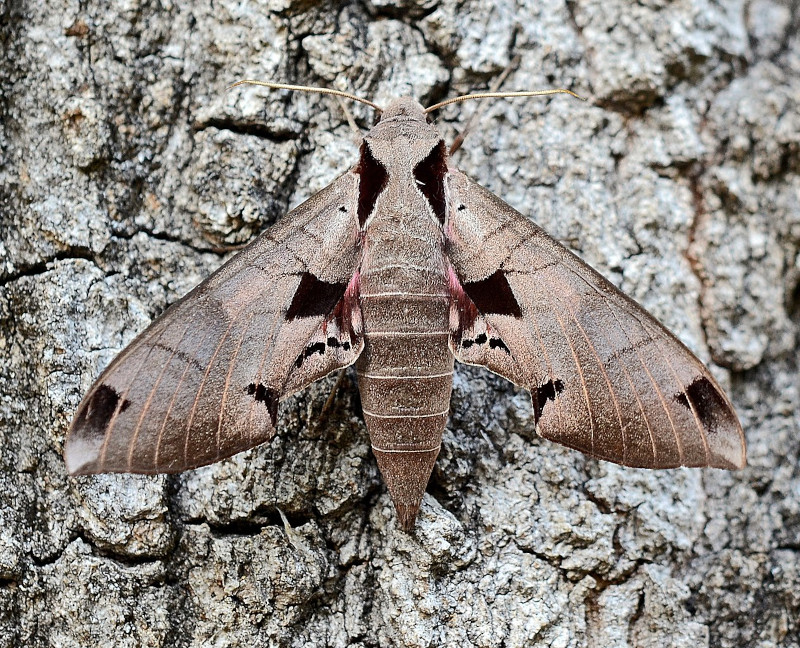
Achemon Sphinx Moth Facts
- This visually captivating Lepidoptera most frequently goes by the somewhat lengthy common name of the Achemon Sphinx Moth. It has only one other broadly accepted general title, though. That’s the nearly identical moniker of the Achemon Sphinx.
- Within the scientific community, however, it’s perhaps better known by its technical designation. Though still difficult for the layperson to pronounce, it’s nonetheless at least similar to the common one. It holds the formal epithet Eumorpha achemon.
- The invertebrate received that scientific epithet due to the efforts of Dru Drury. The respected British entomologist accomplished the first formal recognition of it as a separate and distinct species. He managed that scientifically noteworthy deed in 1773.
- No matter which of these honorifics one chooses to use, the creature stands out from many of its relations. A member of the hawkmoth family, it’s large and strong for its kind. It also often beats its wings so fast it’s sometimes mistaken for a hummingbird!
- Thankfully, the Achemon Sphinx Moth seems to be maintaining a population base that’s both stable and sufficient. That pleasant state also appears to hold true across its known range. The IUCN thus presently has no listing for its on its published Red List.
- The remarkable insect nevertheless still faces the same potential threats to its existence as all species on earth do. Most of these stem from the actions of mankind. They include the perilous duo of habitat loss and the effects of ongoing climate change.
Related Articles

Achemon Sphinx Moth Physical Description
The amazing Achemon Sphinx Moth presents a physique that immediately captivates most individuals who encounter it. Unlike some Arthropods, though, it does so due to more than one simple reason. That’s true since it’s both beautiful and of significant size, as well.
The insect additionally follows a pattern quite common among animals. That’s the fact that it presents a certain degree of the physiological characteristic of sexual dimorphism. In its specific case, that trait manifests itself in terms of gender-based size differences.
Overall, mature adults of the species attain wingspans averaging 3.4 – 3.8 in (8.7 – 9.7 cm). Females do,however, tend to average more toward the higher end of the range than their male counterparts. Exceptional individuals do occur, though, regardless of sex.
The sex-derived physical variations also present themselves in yet another way, albeit a small one. That’s in the size of the abdomen of the animal. That’s true given the fact that among the females this portion of the body typically develops as slightly larger than males.
But, in terms of coloring, both genders of the amazing Achemon Sphinx Moth display the same basic patterns. The head and body show a light tan color, with one exception. Two triangular-shaped dark spots appear on the upper side of the back, near the head.
Meanwhile, the upperside of the forewings shows the same light tan. These, however, also display the same dark shape, two to each wing. Each hindwing presents a mix of tan and pink. The underside of both wings, though, show a general mix of both pink and tan hues.
- Kingdom: Animalia
- Phylum: Arthropoda
- Class: Insecta
- Order: Lepidoptera
- Family: Sphingidae
- Genus: Eumorpha
- Species: E. achemon
Achemon Sphinx Moth Distribution, Habitat, and Ecology
The magnificent Achemon Sphinx Moth evolved as native to an impressively large swathe of the surface of the earth. The exact location of that zone of habitation won’t surprise many people, though. That’s true since it developed as endemic to most of North America.
There, that territory encompasses virtually the entirety of the continental United States. To the north, however, it also extends its presence into much of southern Canada, as well. The southern limits of its native range even reach as far as northern Mexico.
Nature blessed this tantalizing creation of evolution with a certain degree of adaptability in its choice of habitats. Due to this flexibility, it appears across a moderately wide range of ecosystems. This provides it with an evolutionary advantage some species lack.
Though it makes its presence known in many related regions, it mainly prefers scrubby or wooded areas. Yet, it’s seemingly not afraid of human presence in its vicinity. It’s therefore frequently seen in such locations as gardens, parks, and other various suburban sites.
Adults of the remarkable Achemon Sphinx Moth eat the nectar of various locally available flowers. It’s also one of the few known pollinators of a rare orchid variety in its range. The larvae, however, feed voraciously on many plants, including commerical grape plants.
The biology of this natural marvel further varies according to its range. Populations in the more northerly part of its range produce only a single generation per year. Yet, those groups living in the more southerly sections of the territory usually produce two yearly.
Species Sharing Its Range
Check out our other articles on 5 Fabulous Mammals of Florida, Great Potoo, Victoria Falls, Strawberry Tree, Fire Salamander, New Guinea Crocodile, Oceanic whitetip shark, Clouded Leopard
